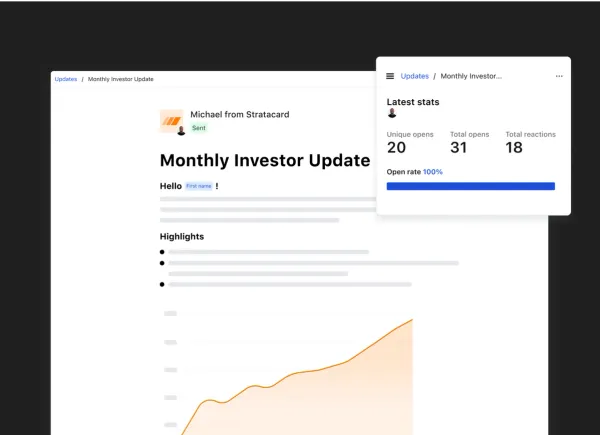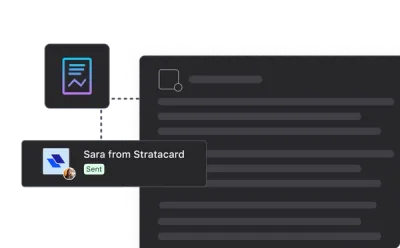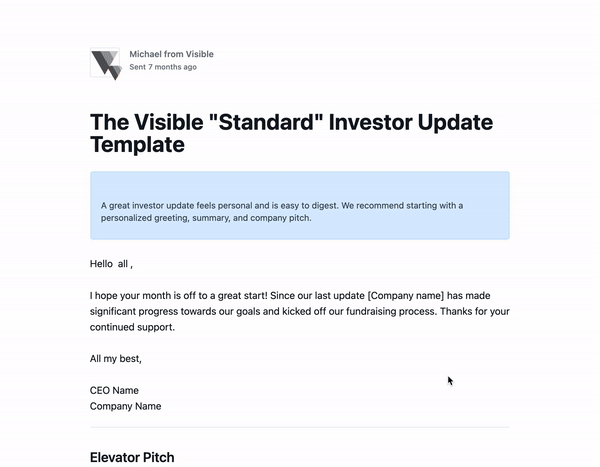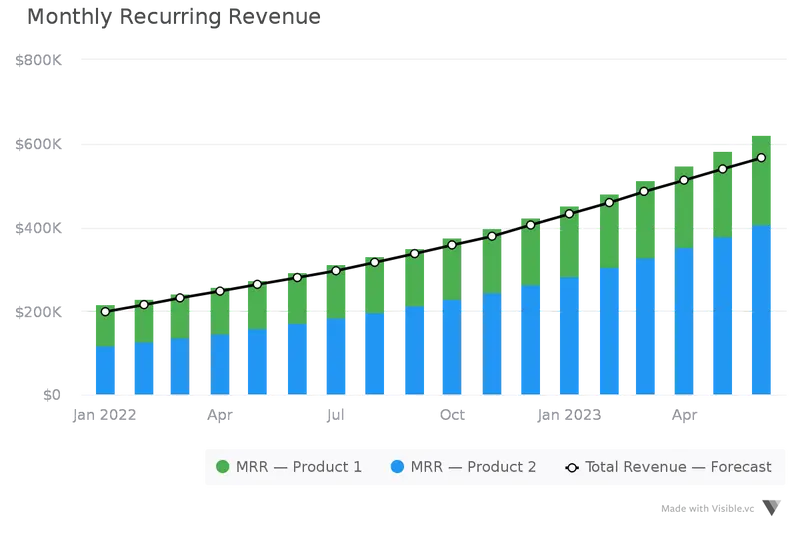
How To Write the Perfect Investor Update (Tips and Templates)

Investor Update Templates Are Only as Effective as the Software Behind Them
Investor updates are essential for building strong investor relationships. While templates can help provide structure, they fall short when it comes to efficiency, engagement tracking, and real-time collaboration. That’s where purpose-built software like Visible comes in.
With the Investor Updates feature inside of Visible, you go beyond static templates and unlock powerful features:
- Engagement Tracking – See exactly which investors open, click, and engage with your updates, so you can prioritize follow-ups strategically.
- Metrics & Charts – Pull in real-time data from sources like QuickBooks and Google Sheets to make updates visually compelling and data-driven.
- Collaborative Drafting & Approval – Easily work with co-founders and team members on updates before sending them out.
- One-Click Sharing & Compliance – Share updates securely via email or our private investor portal—ensuring consistency and professionalism.
Investor updates shouldn’t be a chore. Visible turns them into a competitive advantage, helping you maintain transparency, build trust, and ultimately, raise capital more effectively.
Ditch the static templates—upgrade to an investor update experience designed for growth.
What is an Investor Update?
An investor update is a document that includes recent wins and losses, financials, team updates, customer wins, and core metrics. They are typically shared via email but can also be shared via PDF, deck, or link.
For many startup founders, investor updates are shared every month but can also be shared on a quarterly (or more frequent) basis. Learn more about why and how to create investor updates for your business below:

Why Send Investor Updates?
Step into the shoes of your investors and it will help understand the importance of investor updates. Put simply, an investor’s (venture capitalist) job is to deploy limited partners’ capital by investing in startups, generate excess returns, and pay back their limited partners with the hopes of doing it again. This means that an investor’s success hinges on the success of their portfolio company. Put simply, your investors need you to succeed.
Your investors likely have other investments and can’t be expected to know exactly where to help each company. In a crowded space building, strong relationships centered on trust and transparency is an easy way to stand out amongst other startups. By sending regular investor updates you can stay top of mind for your investors and tap into their knowledge, resources, and capital to continue to grow your business.
Below you will find our guide to help you write the perfect investor update by understanding what metrics and data to share, properly asking for help, sharing big wins and losses, and raising additional capital. We’ve also included 7 of our favorite investor update templates.
Related resource: What is a Capital Call?
Essential Communication
We believe that regular communication with investors and important stakeholders is key to a startup’s success. If your investors don’t know what’s going on in your business, they don’t know how to help. Building a reporting cadence with your investors is a great way to promote transparency and build a relationship focused on trust.
Related Reading: Should You Send Investor Updates?
Follow-On Funding
One of the biggest reasons to report to your investors is the increased likelihood of follow-on funding. In our own research, we have found that companies that regularly communicate with their investors are twice as likely to raise follow-up funding.
Try Visible to find investors, track your raise, share your deck, and update investors. Give it a free try for 14 days here.
Networking Opportunity
Generally speaking, investors' networks often have had experience as an operator and investors. Tapping into their network can be an easy way to find introductions to investors, partners, potential hires, and mentors. Getting an investor to go to bat for you will likely carry a bit more weight. As Tomasz Tunguz, VC at Redpoint Ventures, states;
“Investors network frequently, work together, and have long-term relationships with each other so a referral should go a long way.”
Finding Talent
In hand with tapping into their network, investors are a great resource when it comes to hiring top talent. Between their other portfolio companies and previous experience most investors likely know a number of solid candidates to fill a role. If they don’t have someone in mind for the job, they can at least help talk you through the different candidates you are weighing for an open position.
Knowledge and Experience
Between their own experience and other portfolio companies, investors have seen just about anything. If you have an operational or tactical question investors are a great resource and can lend experience and knowledge.
Related Resources:
- Our 15 Favorite Newsletters for Startup Founders
- How to Write the Perfect Investment Memo
- 3 Tips for Cold Emailing Potential Investors + Outreach Email Template
Accountability & Reflection
One of the often overlooked benefits of sending monthly investor updates is the reflection and accountability it offers founders. Investor updates can be a great forcing function for founders to look back at the previous month or quarter and better understand what is and is not working for their business.
Related Resource: Investor Relationship Management 101: How to Manage Your Startups Interactions with Investors

Tips For Writing Investor Updates
Investor updates can be a tricky balance between informing investors and keeping things succinct and digestible. Most things boil down to keeping your updates consistent and regular.
Keep the Cadence Consistent
If you commit to sending a monthly update, you'll want to make sure you stick to sending an investor update every month. Skipping an update when times are tough can be a negative signal to investors.
Keep Metrics the Same
Make sure to keep the metrics you are tracking stay the same from month to month. For example, if you are calculating net new MRR using a certain formula, keep that consistent from month to month.
Stick to a Format
When creating an update, sticking to a regular format or template is a great way to help get the ball rolling every month. If you're not sure where to get started, we studied our data to understand the most popular components founders include when using our investor update software, check it out below:
- 81% of Updates include “Highlights”
- 47% of Updates include a “Team” section
- 42% of Updates include “Product Launches”
- 42% of Updates include a “KPIs” section
- 39% of Updates include a “Fundraising” section
Investor Update Templates: Examples For Your Next Update
Sending your first investor update can be a daunting task. We believe that the best place to learn is from someone who has been there before. Luckily, countless founders and investors have shared their templates and best practices for sending investor updates.

We suggest starting with a template you like and tweaking it to your needs (more on this later). Once you’ve found your format, it is all about making sure you keep tabs on the data and context so you are not scrambling when it is time to send. A couple of small steps when sending your first Update:
- Gather your data — As you should be sharing other a few metrics with investors, it is important to keep tabs here. These should be vital to your business and something that you have on hand at all times.
- Review the month — A perk of sending an investor update is the ability to look back at the previous month. Think about any major highlights, lowlights, areas you need help, so you can start to craft your Update.
- Add context — Sharing your data without context can be dangerous. Do your best to explain any metric movements.
- Send it — Getting your update sent out a consistent basis is a win. If you’re looking to get an idea of when founders using Visible send their Updates, check out our post, “Most Popular Times to Send Your Investor Update.”
1. Techstars Minimum Viable Update
In the “Minimum Viable Investor Update”, Jens Lapinski, Former Managing Director of Techstars METRO, lays out 3 items that he finds most useful in his portfolio early-stage company monthly updates.
2. Founder Collective “Fill-in-the-Blank” Investor Update Email Template
An investor Update template for busy founders put together by the team at Founder Collective. Simply fill out the bolded sections and have your investor Updates out the door in no time.
3. Kima Ventures Investor Update Template
An Update template put together by Jean and the team at Kima. Quickly fill in the quantitative and qualitative data Kima finds most useful.
4. GitLab Investor Investor Update Email Template
A 6 part template put together by the team at GitLab. Built for investors to quickly read and locate the information that is most relevant to them.
5. Y Combinator Investor Update Template
An investor update template from Aaron Harris of Y Combinator. Aaron recommends highlighting repeatable key performance indicators (KPIs) and major asks for your investors.
6. Shoelace: Investor Update Email Template
A template based off of Reza Khadjavi’s, Founder & CEO of Shoelace, investor update email used to wow investors.
7. The Visible “Standard” Investor Update Email Template
Our Standard Monthly Investor Update template put together from best practices and tips from Visible users.
For more ideas, check out our investor update template library here.
Related Reading: 4 Items to Include in Your Next Investor Update (If You Want to Drive Engagement)
8. Bread & Butter Ventures Update Template
Bread & Butter Ventures is an early-stage VC firm based in Minnesota investing globally while leveraging their state and region’s unparalleled access to strong corporate connections, commercial opportunities, and industry expertise for the benefit of our teams. Learn more about what Brett Brohl of Bread & Butter Ventures likes to see in an Update below:
Sharing Metrics and Data
Determining what metrics and key performance indicators (KPIs) to share with your investors can be tricky. There are a slew of different key metrics and different investors may have their eyes on different things. Changing metric names or what you are reporting can be an easy way to break trust with investors. At the end of the day, it is most important that you share the same metrics from month to month. And as we’ve discussed before, it is okay to share bad months!
We suggest sharing a handful of key performance indicators (KPIs) with your investors. Depending on your relationship, some may only want to see 3 metrics while others may want to see 10. Talk with your investors and discuss what types of key metrics they’d like to see. A couple of examples are churn rate, number of active users, monthly recurring revenue (MRR), burn rate, and more.
Related reading: Startup Metrics You Need to Monitor
Every company has missed the mark and any investor is aware that this happens. Building a company is hard! With that being said, we do have a few areas where investors would expect some data:

Revenue
Being able to generate revenue is essential to a business. However, you determine to measure revenue should be kept consistent from month to month. For example, don’t share bookings one month and revenue the next. For SaaS companies, including your monthly recurring revenue (MRR) and the movements are always good to include as well.

Cash Flow
Cash is king. Cash is the lifeblood of your business and investors expect some insight into how their capital is being managed and used. This is also a great way for you as a founder to stay accountable and on top of your spending as you continue to grow your business.
Burn Rate
As we mentioned above, cash is king. By tracking and reporting your burn rate, you will be able to avoid surprises with investors. A common mistake we see founders make is surprising their investors when their cash balance is low and months to 0 is nearing. Sharing your burn rate is an easy way to build trust with your investors and give them a better idea of when you’ll need to raise a new round.
Margins
Generating solid margins is a must for any successful business. Except the “gig economy,” Frank Mastronuzzi of Greenough Consulting Group suggest that every business should have at least a 55% margin. While likely more important during a fundraise, sharing your margins will help investors evaluate your COGS and acquisition costs.
Number of Active Users
Depending on your company goals and KPIs, the number of active users could be valuable to understanding growth.
Churn Rate
Being able to keep your burn rate under control is an easy way to grow your business. In the early days, some investors may want to keep close tabs on burn rates to understand what part of your funnel may be lacking.
Customer Acquisition Costs
Being able to efficiently acquire and expand customers is a surefire way to grow. Without a sustainable way to acquire new customers, a business will struggle to grow or even exist.
Related Reading: Customer Acquisition Cost (CAC): A Critical Metrics for Founders
Sharing Wins and Losses
One of the most exciting aspects of being a founder is sharing and celebrating your victories. As we all know, with every victory comes plenty of losses. Investors are keyed in on your success so it is important to stress both wins and losses equally.
Sharing Wins/Highlights With Investors
Sharing your company’s accomplishments is generally pretty straightforward. Share why and how you accomplished your goal and carry on. Investors generally won’t be able to move the needle for your wins but is best to keep them informed so they can signal to their network of your successes.
Most important is to call out individual contributors when it comes to sharing major accomplishments. All employees like to be recognized for their contributions and there is no greater place to do so than in front of your outside stakeholders.
Along the lines of sharing individual kudos, it is also a great time to highlight new hires. A shout-out to new hires will make offer them a warm welcome and the chance to open up to investors.
Sharing Losses/Lowlights With Investors
The most dreaded and arguably the most important aspect of an investor update; sharing losses. Startups are hard and everyone involved with the process knows this. It is vital that you key your investors into any troubles you are facing and why you are facing them. We find it best to layout the lowlight and offer a solution to improve this moving forward (If you do not have a solution read on to the “Asking for Help” section below).
Generally speaking, nothing is ever as good or as bad as it seems. Sharing bad news is an easy way to strengthen your relationship with investors and they know you’ll be open and honest with them moving forward. Most importantly, this gives your investors an opportunity to step in and help to keep you moving in the right direction.
Related Reading: How to Deliver Bad News to Investors

Asking Investors for Help
Last but certainly not least is asking your investors for help. While every section mentioned above lends itself to asking questions, it is most important to lay out actionable questions where you believe your investors can help.
By laying out a pointed list of areas you could use help, you can easily tap into your investors’ network, resources, experiences, and capital. A couple of key areas we see founders have the most success:
Related Resource: Navigating Investor Feedback: A Guide to Constructive Responses
Closing Deals
From our article, “You Should be Asking Your Investors for Help. Here’s How.”
“At its core, building a VC-backed business is about generating revenue. The biggest value add for a business? Closing more deals. Your investors are in the “deal-making” business and likely have a knack for closing deals.
Use your investor’s professional networks to make an intro, set a meeting, or bring in the necessary backup to close a large deal. If you see your investor has a specific connection you’re looking for, don’t beat around the bush. Ask the investor for the exact intro you’re looking for and tell them how they can be of most value.”
Help With Hiring
Talent is the resource every company is in competition for on a daily basis. Any tool or resource you can use to find top talent for your business is worth leveraging. Investors generally happen to help fill an open role and often have an extensive network to do so. Be specific as possible about the role, as well as items like the experience level required, and target compensation to make it low-maintenance for your investors.
Pro tip: Include a direct link to a LinkedIn search that fits the criteria of the person you’d like to hire to make it easy as possible for investors.
Fundraising
One of the main reasons to send investors monthly updates is the increased likelihood of raising follow on funding. If you have properly communicated with investors, chances are they will be more enthusiastic to invest in your next round. We have found that companies that regularly send investor updates double their chances of raising follow on funding. When it comes down to it and an investor has to make a decision between 2 investments; 1 that has been communicating and 1 that has not been communicating. It is easy to go with the one that has been transparent and has made an effort to build a relationship.
Even if your investors are not interested in committing follow-on capital, they may be able to introduce you to other investors they know. Investors know other investors. Venture capital is a tight-knit community and one positive recommendation can make waves.
Related Resource: 9 Tips for Effective Investor Networking
Pro tip: Include a light version of your pitch deck that investors can circulate with investors they can make an intro to.
Recommended Reading: How to Write the Perfect Investment Memo
Investor Update Template Real Life Example
If you’ve browsed through our investor update template, you’ve probably noticed they share a lot of similarities. Most of the Updates include the sections listed above. Of course, every business is different. The size, stage, and relationship with your investors will impact your Update template.
In order to help you best write an Update, let’s use a real-life example. Let’s say we are a seed stage SaaS company that has recently raised $1M and we are starting to scale revenue:
The Intro
First things first, we need to write an introduction. This can be as personalized or informal as you’d like. We suggest something like the following:
“Hey Investor Name — Hope all is well! I can’t believe August is already in the books. We had a great month that we’ll dig into below. As always, feel free to reply back to this email with any questions or give me a call at 123.456.7890.”
Highlights
We suggest starting with highlights. This will set the tone for the Update and give investors a quick rundown of what is going well for your business. This should include things like new hires, product updates, and growth (always try to quantify if you can!). Here is an example of some company highlights:
- We just hired person X to head up our sales team. They bring 10+ years of experience in the space and are going to be a great fit. You can connect with them on LinkedIn here.
- We have finally gotten New Product Y out of beta and into the hands of our users. Early signs show a big opportunity. We’ve increased usage by 50% week over week and have already exceeded our quarterly goal of Y users.
- Our sales team is on fire! We’ve closed our largest 2 clients to date — Big Name A and Big Name B. Both are great logos and are our largest contracts to date.
Lowlights
Sharing lowlights is never. However, it is a crucial part of building trust with investors so they can help you overcome pain points. Including steps for how you plan to fix the problem is always appreciated. Check out an example below:
- We have been struggling to find a customer success leader. We’ve opened up our search to new job boards and are offering a bonus to anyone who refers a new hire. If you know anyone that fits these parameters, please send them our way.
- New trials have been lagging behind pace. In order to help get this back on track, we are bringing in an SEO specialist to help us increase website traffic and website-to-trial conversion.
Asks
Ask are potentially the most beneficial aspect on an investor update. As you are requesting help from your investors, be as pointed and direct as possible to make it easier on them. Here are some examples:
- Here is our target list of investors for our Series A round and our most up to date fundraising deck. We’re looking for introductions to any of the investors listed in the ‘Research’ stage.
- We’re looking for introductions to candidates for this [specific job title] in the [specific industry]. Ideally, this person would work at a company with at least X employees and control his own budget.
- Do you know someone I should meet in [specific city]? I’ll be traveling there next month and am trying to fill my calendar.

Metrics
As we mentioned above determining what metrics to share is up to you and your investors. For our example, we’ll focus on a couple of key metrics every company should be tracking. Here is an example of how you might present that data:
KPI 1

As we mentioned earlier, revenue has been cruising this month. It is our best month to date and we’ve closed our largest customers.
KPI 2

As you know, our team has been rallied around improving our True North KPI. Our recent product pushes and GTM campaigns have really paid off as shown above.
KPI 3

I feel great about our cash position. We have 18+ months of runway so I can stay focused on building the business and don’t have any immediate need to raise capital.
Try Ranking Your Investors
Just as investors are comparing you to their other investments don’t be afraid to rank your investors relative to their peers. As Brock Benefiel, business author writes,
“Ranking investors can be an intimidating idea, but when done right can provide a useful way for founders to spur increased engagement from their investors and better illustrate their additional needs from the board. To handle it in the most tactful manner, focus less on creating a zero-sum, Game of Thrones-style battle between investors for the top spot and instead provide up-to-date developments on how investors have made a specific impact on the business.“
Related Resource: Investor Relationship Management 101: How to Manage Your Startups Interactions with Investors
Related Resource: How to Find Investors
Related Resource: 6 Helpful Networking Tips for Connecting With Investors
Get Started with a Visible Update Template
Getting in the habit of sending monthly investor updates is a surefire way to help with fundraising, hiring, and growing. To get started, pick a template from our library and tailor it to your business. Just remember that at the end of the day, sending anything is better than sending nothing at all.
Related Resource: Best Practices for Creating a Top-Notch Investment Presentation
Visible allows founders to update investors, track key metrics, and raise capital all from one platform. Try Visible for free to send your next investor update.
To learn more about sending your first update with Visible, check out our guide (with videos).



